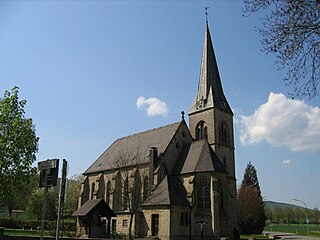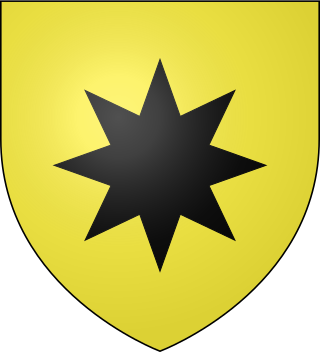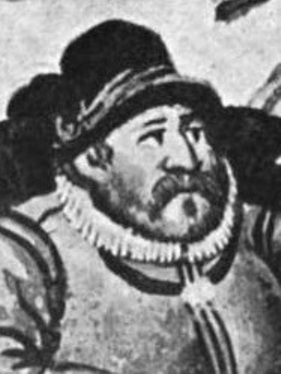
The County of Waldeck was a state of the Holy Roman Empire and its successors from the late 12th century until 1929. In 1349 the county gained Imperial immediacy and in 1712 was raised to the rank of principality. After the dissolution of the Holy Roman Empire in 1806 it was a constituent state of its successors: the Confederation of the Rhine, the German Confederation, the North German Confederation, and the German Empire. After the abolition of the monarchy in 1918, the renamed Free State of Waldeck-Pyrmont became a component of the Weimar Republic until divided between Hannover and other Prussian provinces in 1929. It comprised territories in present-day Hesse and Lower Saxony (Germany).
Waldeck-Frankenberg is a Kreis (district) in the north of Hesse, Germany. Neighbouring districts are Höxter, Kassel, Schwalm-Eder, Marburg-Biedenkopf, Siegen-Wittgenstein, Hochsauerland.

Warburg is a town in eastern North Rhine-Westphalia, central Germany on the river Diemel near the three-state point shared by Hessen, Lower Saxony and North Rhine-Westphalia. It is in Höxter district and Detmold region. Warburg is the midpoint in the Warburger Börde. Since March 2012 the city is allowed to call itself 'Hanseatic City of Warburg'.
Cunigunde of Luxembourg, OSB, also called Cunegundes, Cunegunda, and Cunegonda and, in Latin, Cunegundis or Kinigundis, was Empress of the Holy Roman Empire by marriage to Holy Roman Emperor Henry II. She ruled as interim regent after the death of her spouse in 1024. She is a saint and the patroness of Luxembourg; her feast day is 3 March.

Bad Arolsen is a small town in northern Hesse, Germany, in Waldeck-Frankenberg district. From 1655 until 1918 it served as the residence town of the Princes of Waldeck-Pyrmont and then until 1929 as the capital of the Waldeck Free State. The International Tracing Service has its headquarters in Bad Arolsen.

Battenberg is a small town in the district of Waldeck-Frankenberg in the state of Hesse, Germany. It is located on the river Eder, a tributary of the Fulda, which flows into the Weser, and lies at the southeastern edges of the Rothaar Mountains. The closest larger cities are Marburg, Siegen, and Kassel, and the town is approximately equally far away from Frankfurt am Main, Cologne, and Dortmund.

Korbach, officially the Hanseatic City of Korbach, is the district seat of Waldeck-Frankenberg in northern Hesse, Germany. It is over a thousand years old and is located on the German Timber-Frame Road. In 2018, the town has hosted the 58th Hessentag state festival.

Willebadessen is a town in Höxter district and Detmold region in North Rhine-Westphalia, Germany.

Willingen is a municipality in Waldeck-Frankenberg in northern Hesse, Germany, some 80 km west of Kassel.

Kaufungen Abbey was a Benedictine nunnery founded in 1017 by the Empress Cunigunde of Luxembourg, wife of Henry II, Holy Roman Emperor, located in Kaufungen in Hessen, Germany.

The German Fairy Tale Route is a tourist attraction in Germany originally established in 1975. With a length of 600 kilometres (370 mi), the route runs from Hanau in central Germany to Bremen in the north. Tourist attractions along the route are focused around the brothers Wilhelm and Jacob Grimm, including locations where they lived and worked at various stages in their life, as well as regions which are linked to the fairy tales found in the Grimm collection, such as The Town Musicians of Bremen. The Verein Deutsche Märchenstraße society, headquartered in the city of Kassel, is responsible for the route, which travellers can recognize with the help of road signs depicting the heart-shaped body and head of a pretty, princess-like creature.

Schöneberg is a village and a municipal division (Stadtteil) of the town of Hofgeismar in the district of Kassel in northern Hesse, Germany. West of the village, there are the ruins of a castle dating from the 12th century that bears the same name.

Countess Juliane of Nassau-Siegen, German: Juliana Gräfin von Nassau-Siegen, official titles: Gräfin zu Nassau, Katzenelnbogen, Vianden und Diez, Frau zu Beilstein, was a countess from the House of Nassau-Siegen, a cadet branch of the Ottonian Line of the House of Nassau, and through marriage landgravine of Hesse-Kassel.

Count Wolrad II 'the Scholar' of Waldeck-Eisenberg, German: Wolrad II. 'der Gelehrte' Graf von Waldeck-Eisenberg, was since 1539 Count of Waldeck-Eisenberg.

Count Wolrad IV 'the Pious' of Waldeck-Eisenberg, German: Wolrad IV. 'der Fromme' Graf von Waldeck-Eisenberg, official titles: Graf zu Waldeck und Pyrmont, was since 1588 Count of Waldeck-Eisenberg. He founded of the new line of Waldeck-Eisenberg.

Count Christian of Waldeck-Wildungen, German: Christian Graf von Waldeck-Wildungen, official titles: Graf zu Waldeck und Pyrmont, was since 1588 Count of Waldeck-Eisenberg and after the division with his brother in 1607 Count of Waldeck-Wildungen. He founded the new cadet branch of Waldeck-Wildungen and is the progenitor of the princes of Waldeck and Pyrmont.

Count Josias I of Waldeck-Eisenberg was a German nobleman who was Count of Waldeck-Eisenberg from 1578 until his death.

Count John I 'the Pious' of Waldeck-Landau, German: Johann I. 'der Fromme' Graf von Waldeck-Landau, was since 1539 Count of Waldeck-Landau. He was the founder of the younger cadet branch of Waldeck-Landau.

St Martin's Church is a Protestant parish church in Kassel, Hesse, Germany. It is also the preaching-church of the bishop of the Evangelical Church of Hesse Electorate-Waldeck. It is in the Gothic style and was begun in 1364 and completed in 1462, dedicated to St. Martin of Tours. It became a Protestant church in 1524, when Philip I, Landgrave of Hesse converted to Protestantism. From the 16th century until the end of the 18th century it was the burial place for the landgraves of Hesse.
The Mainz-Hessian War of 1427 was the final military conflict in the two-century long dispute between the Archdiocese of Mainz and Landgrave of Hesse over supremacy of the Hesse region. The decisive victories of Landgrave Ludwig I over the Mainzian military leader Gottfried von Leiningen near Fritzlar and over Archbishop Konrad von Dhaun near Fulda spelled the end of Mainz's ambitions in the Hesse region. The Peace of Frankfurt, signed on December 8, 1427, decisively ended both the war and the long-standing power struggle between Hesse and Mainz.























